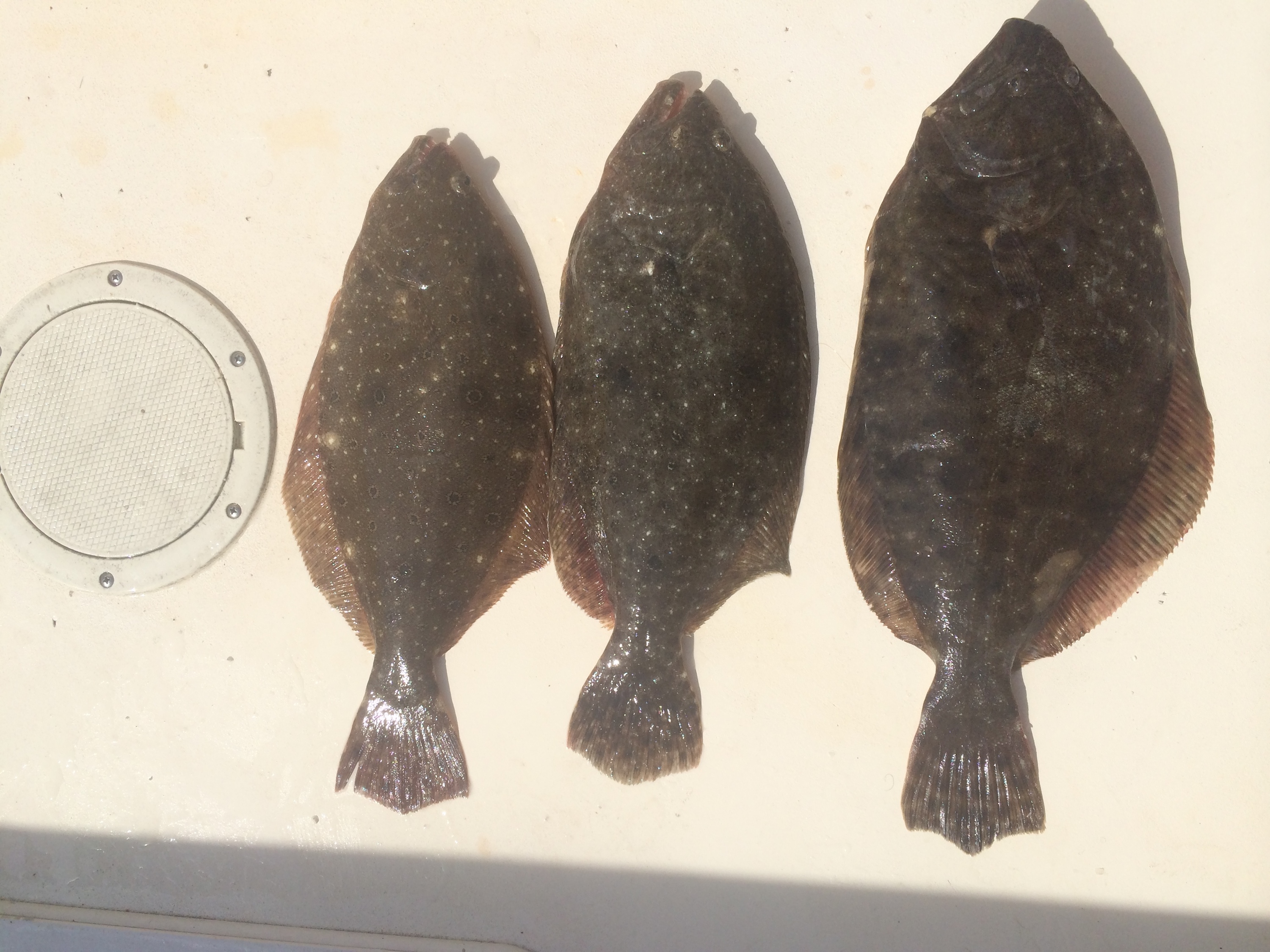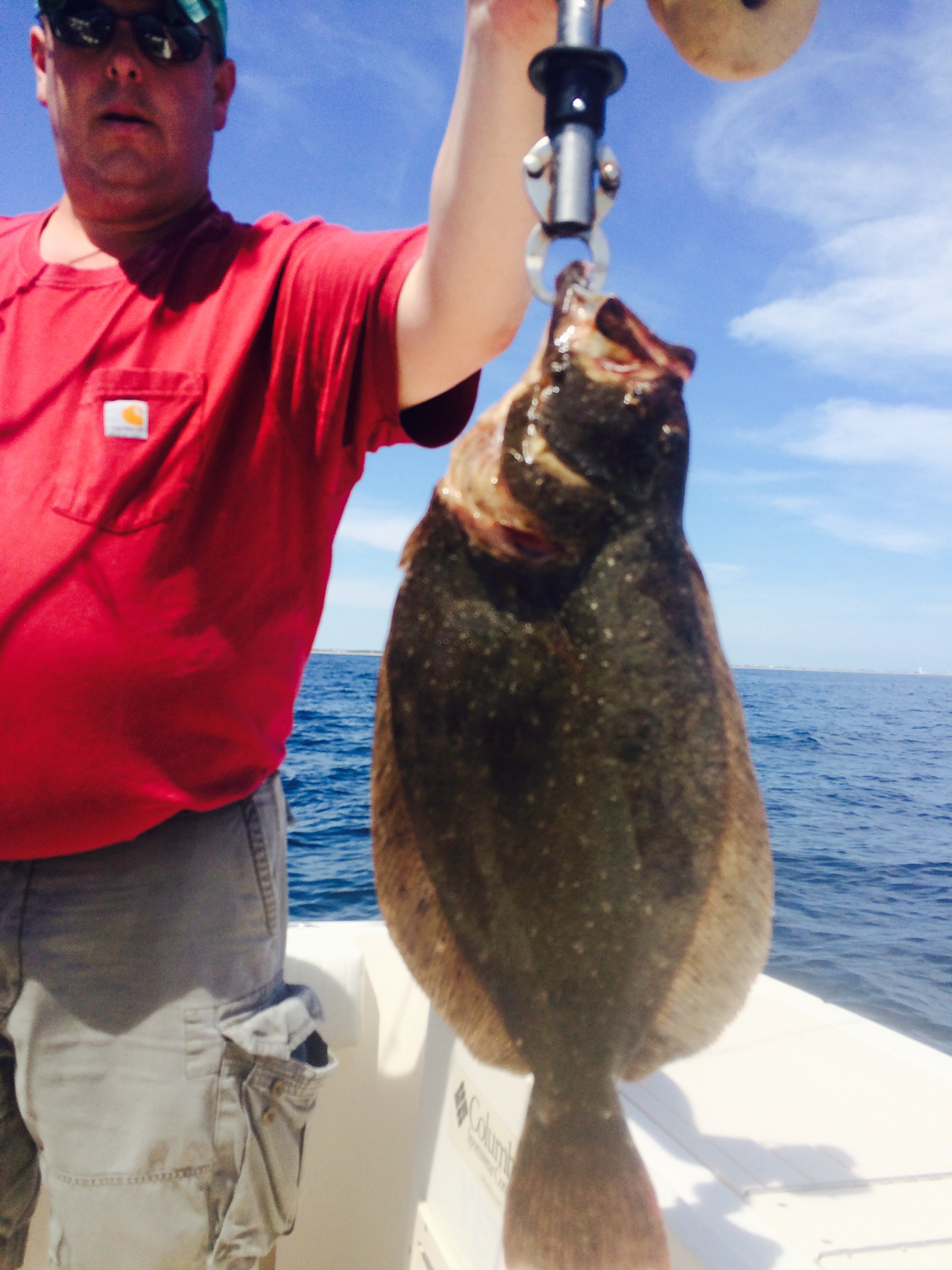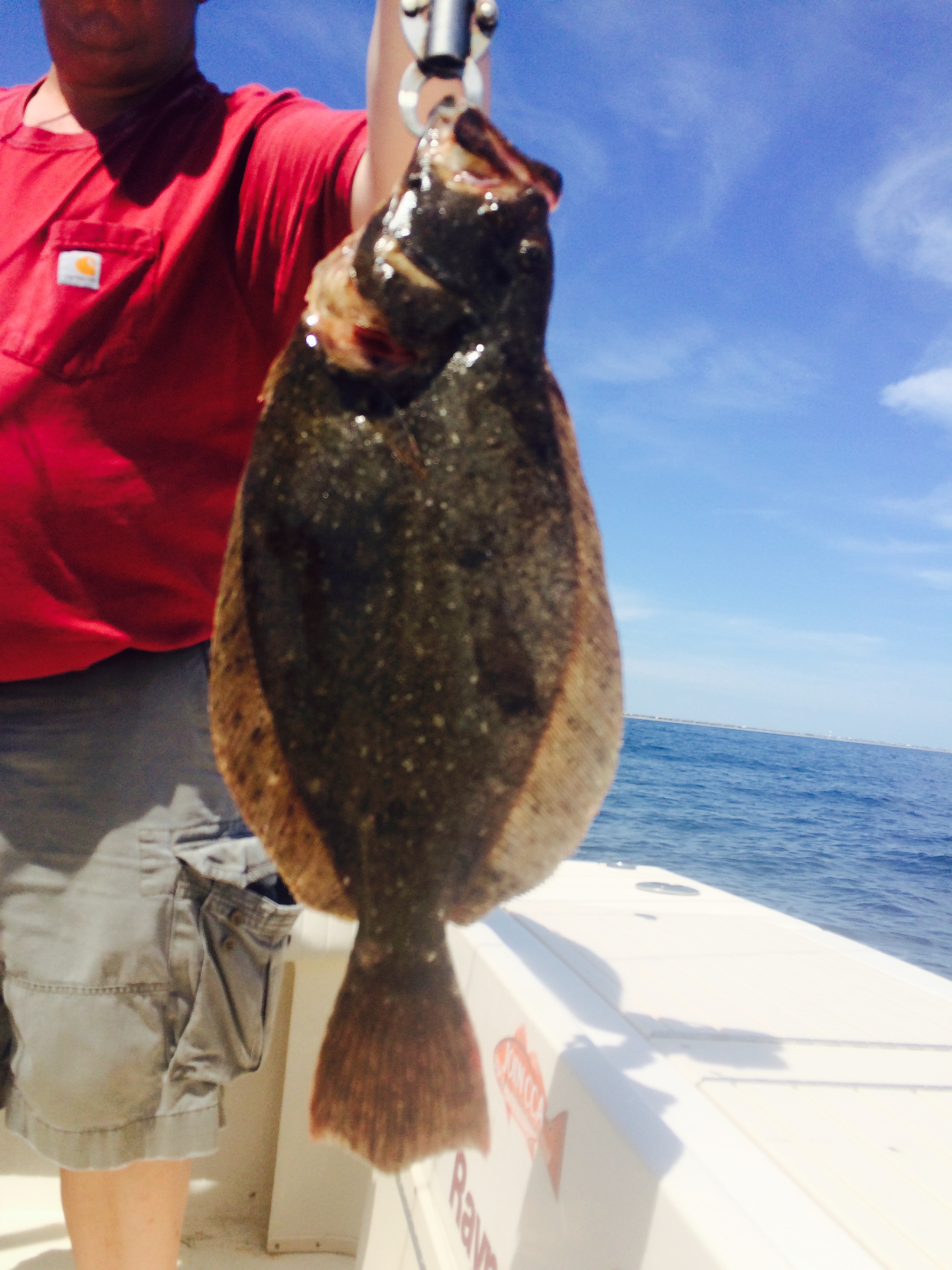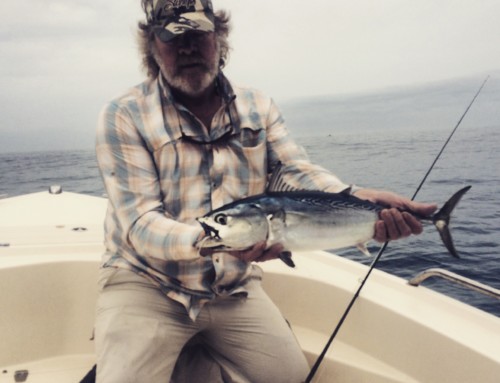Right now flounder is THE big topic in North Carolina fisheries. If you follow NC fisheries politics – it’s probably front and center for you. If you don’t get into the policy side of things and just like to fish – flounder is probably on your mind. More specifically – where did they go? Why can’t we catch them like we did 10, 20 or 30 years ago? And why do I catch so many small undersized flounder but can’t find a keeper?
Flounder is our most important recreational fishery in value – why? Because who doesn’t like to eat flounder?!?! Just the idea of being able to go out and catch a keeper flounder is enough to make many a fishermen hit the pier, grab their surf gear or venture out into the marsh or ocean to try to put a couple on ice for dinner.
Today, if a fisherman ventures into the marsh to try to catch a few keepers, he or she is likely only to find a good amount of 10-14.5″ fish….and this is the reality of our southern flounder stock. And it’s a sad reality for NC recreational fishermen.
What a lot of anglers, even many guides, don’t know is that we catch 3 species of flounder in North Carolina. While all three overlap quite often, they typically utilize different areas. Depending on where you fish, and how, you are most likely to see one of the species predominantly.
These species are Southern Flounder, Summer Flounder and Gulf Flounder. Yes – it’s quite confusing.
The first picture of this post displays all three species side by side – this photo is from last summer after a charter fishing the nearshore wrecks.
The fish on the left, the smallest, is a Summer Flounder. They are most easily recognized by their distinct “ocellated eye spots.” We are the extreme southern range of this fish species and this is the species that they refer to as a Fluke up in New Jersey, New York, etc. They get quite big up north and the coast-wide stock is extremely healthy and a real gem of successful fisheries management (thank the awesome Mid-Atlantic Council!). This is the species you are most likely to eat when visiting a coastal NC restaurant – the commercial fishery is ocean trawling, mostly from Virginia to Massachusetts, and the catches are large…much of this fish is flash frozen in the winter and makes its way to your fish tacos and fried flounder platter in our coastal, and elsewhere, restaurants. Nothing wrong with that!
In NC you are most likely to encounter summer flounder in high-salinity areas like the inlets and surf areas. We do catch them on the wrecks as well, and less frequently in the marshes near the inlets. Drifting the inlet is a common way to catch these guys. In NC they tend to be quite small and finding a keeper can be tough.
The fish on the right, the biggest, is a southern flounder. This is our predominate North Carolina flounder – we are their most northern range and the fish is found from NC all the way to Texas. This species is often very dark in color and doesn’t have any ocellated eyes spots – just different color mottling. It’s our most valuable recreational finfish and most valuable commercial finfish found in state waters. If you’re fishing western Albemarle Sound, the Neuse River, way up the Cape Fear – anywhere in the estuary from the lowest salinity areas to the highest…this is the flounder you’re most likely to catch. It’s also most likely to be the biggest of the three species in NC. While we still catch them on the wrecks, we do not catch them in the numbers we used to – the stock has been overfished for 23 straight years and is in a lot of trouble.
I used to do really well with these guys in the marsh, the docks and on the wrecks. While we still catch them, the fishery is nowhere near what it was just 5 years ago, and definitely not 10. While I’ll get to this more later, the problem with the stock isn’t recreational fishermen. It’s an over-capitalized commercial gill net fishery that is the problem. Nearly 800,000+ recs harvest less than 20% of the overall catch while less than 1,000 gill netters harvest 45% of the overall catch! Large mesh gill nets are one of the most horrible and destructive commercial fishing gears ever to be allowed in estuarine waters. Our state fisheries managers claim gill nets are “selective” in that they only catch fish of a particular size. The truth is that they are only selective in that they are extraordinarily efficient in catching most every species of a particular size. They catch and drown most everything that swims. They are set for flounder, but often have more bycatch of red drum, trout, black drum, sea turtles, etc. than they catch in flounder. Much of this “bycatch” is valuable recreational species that remove tens of millions of dollars from our economy by being gill netted. We allow our fishermen to sell this “bycatch” for pennies on the dollar, compared to its recreational value, because it’s “dead anyway.” The estuarine gill net fishery is a biological and economic abomination. Despite the recreational flounder fishery being worth more than $50 million and part of a greater estuarine recreational fishery ( drum, trout, etc) worth over $250million – we manage the fishery solely to keep large mesh gill nets, a fishery worth less than $5million, in the water. A fishery that kills threatened and endangered sea turtles, dolphins, birds and many important recreational finfish stocks like red drum. The large mesh southern flounder fishery is arguably the least sustainable fishery in the entire United States.
I’ll touch on this more later.
The fish in the middle is the gulf flounder. They are often confused with the other two, and in my opinion, are very often confused with southern flounder and may even be skewing NC fisheries catch statistics. They vary in color, from light to dark, but the easiest way to distinguish them is from their three somewhat faint (compared to a summer flounder) eye spots that make a large triangle that points towards the tail. Once you learn to see this – you can recognize the majority of them from a long way away! While we catch them in the marsh in high-salinity areas, we most often find them on the ocean wrecks and hard-bottoms from the beach to offshore. This is one of my favorite styles of fishing, and many of your who fish with me have bounced many a jig on the wrecks! While the average gulf flounder is usually 2-3lbs, they don’t get very big and the all tackle world record, which was caught in NC’s Bogue Sound, is just shy of 7lbs! I’ve caught them up to 6.5lbs and NCDMF staff has aged several of the carcasses that I’ve donated and the biggest ones have been 11-12 years old. They grow considerably slower than our southern flounder for sure.
With the estuarine stock not as reliable, when folks ask me to go flounder fishing – I take them to the wrecks. “Thank God for gulf flounder!” is what I often say. A species that utilizes a habitat that is safe from gill nets. Their range, which is again NC to TX (like the southern), seems to mostly be limited, in NC, from Cape Lookout to Wilmington. A quick study of social media and website posts by guides in SE NC really demonstrates that these guys makes up a large percentage of the current catch particularly as many of us need to go to the wrecks and rocks to find good numbers of fish for our clients.
Gulf flounder can be hard to identify particularly if they are not seen side-by-side with another species. In my opinion they are often mis-identified with southerns unless the creel-surveyor looks carefully. The state doesn’t think the average recreational angler can tell the difference between the 3 species so we have a single bag limit of 6 of all species.
The second picture, which was taken the week of this post, is of a 3lb gulf my client landed (Along with a bunch of other gulfs) at a nearshore wreck. I like this photo because the fish is dark and harder to identify but if you look closely you can see that two of its spots are fairly clear with a third being hard to see. They are much easier to identify while still alive – once they have been on ice for a while they darken up and the spots are harder to identify.
The gulf flounder has become the predominate OCEAN catch for most of us in Carteret County and Southeastern NC. If the state is to adopt stricter regulations on recs, because of its inability to properly manage our southern flounder fishery, those of us who fish in the ocean and catch gulf are the ones, pardon my French, who are going to get screwed. But if you’re a recreational fisherman in NC – you’re used to being placed way at the back of the line behind gill nets and the rest of the commercial gears.
Thoughts on management.
As the state of NC, at the hands of the NCDMF and through a lack of past MFC decisions, has absolutely “managed” our southern flounder to the brink. By manage we mean something quite clear – the state has failed to make any incremental or significant changes to the fishery and move it to that of a modern fishery. Whether it’s due to a lack of willingness to make hard decisions, due to a fear of the commercial lobby, or just a poorly informed or biased approach…one thing is clearly evident….our decision and rule making body is trying to pretend that we’re fishing in the 1950s or 1960s. Our coastal population is growing. Recreational fishing is more popular. …and we’re trying to keep the fishery at a “historic” allocation by prioritizing commercial gears. Or as many of us say – the state is fighting to keep the large mesh gill nets in the water AT ALL COSTS.
For those of you who are not aware – the large mesh gill net fishery is THE biggest problem gear in NC waters. It’s the gear that is left unattended in the marsh and is what catches not just the majority of the flounder, but also the majority of the commercially caught red drum, etc. This destructive problematic gear is rife with problems and is what causes the “localized depletion” (aka – wiping out an specific area by pinpoint over-harvest) so many of us have experienced. While a know-it-all fisheries manager will call this a “user conflict” it’s a lot more than that – it’s bad fisheries management and extremely bad economics.
Let me be very clear here – I support the commercial southern flounder fishery. The sustainable portions of it that is – specifically the pound net fishery and the gig fishery. They are both clean, benign fisheries that provide a superior product for market. Even though our restaurants mostly serve summer flounder due to its availability, it’s a great thing to have access to a fresh local product like southern flounder.
So even though our commercial catch can easily be caught using wonderfully sustainable gears like pound nets and gigs…we choose to allocate the majority of the fish to the gill net fishery. Not only that – pound net fish earn more money at market as they are not as beat up and have a better shelf life. Gigged fish are the same…and gigging can bring high per pound prices during the summer when gill nets are closed due to turtle interactions. What’s even more astounding is that the majority of the gill net fishery takes place in the fall during the exact same time as the pound net fishery! We’re essentially flooding the market with a cheaper, inferior product that likely brings down the price of the pound net caught fish.
I’m going to use some basic numbers – I’m rounding a couple percentage points
- Gill nets harvest 45% of the overall harvest.
- Pound nets 28%
- Commercial gig (and other gears) 6%
- Recreational (hook and line and gig) 20%
At the same time – our recreational fishery has suffered as the size and quality of the fishery has declined. More than half the recreational catch is discards – undersized fish that die after being thrown back. Most of these flounder are caught while fishing for other species – like trout and drum, etc. The commercial lobby likes to point to this as the problem. Granted it’s bad, I agree. But the problem is that the fishery has been managed to accommodate gill nets with all their inherent problems. Those gill nets, and current size restrictions, have given recs a fishery of almost entirely small, undersized fish.
So why is the large mesh southern flounder fishery the least sustainable commercial fishery in the USA?
(For the record – and this is a challenge – if anyone can find a US fishery that is less sustainable, please let me know)
- First of all, North Carolina is the only state with a gill net fishery for southern flounder.
- NC is the only southern state with a large mesh estuarine gill net fishery PERIOD.
- The primary target species, southern flounder, has been overfished with overfishing occurring for 23 years in a row!
- When gill nets are used, the sustainable pound net fishery catches less fish. We’re taking fish from a sustainable gear, that earns more money per pound!, and allocating it to a destructive gear. Does that make any sense?
- This fishery is extraordinarily hard to manage. Literally half the fisheries rule book is gill net regs. Every body of water has different rules. Yardage limits. Shot lengths. Set times,. Temporary turtle closures. Partial turtle closures. Yearly turtle closures, etc. It’s so insanely complicated that even the experts from the state can’t follow all of it. Decades of compiled rules into this enormous bloated Rube-Golberg management scheme
- Large mesh gill nets kill large amounts of valuable recreational finfish stocks like red drum & speckled trout
- *NC has the largest commercial fisheries for southern flounder, red drum (over 90% what’s on the market) and speckled trout (over 75% of what’s on the market) in the country and you can thank our large mesh gear for that, particularly for southern flounder and red drum.
- Because gill nets have a very high mortality rate and catch so many small flounder, they get a size limit of 14″ (as opposed to a rec size limit of 15″) giving them priority access to the fish before they reach the rec minimum
- Large mesh gill nets kill dolphins.
- Large mesh gill nets kill countless sea birds.
- Large mesh gill nets kill endangered Atlantic sturgeon
- Large mesh gill nets kill hundreds of endangered and threatened sea turtles (most often greens, loggerhead and kemps ridley)
- BECAUSE of the problems with sea turtles and sturgeon, the state has to provide observer coverage to keep the fishery in compliance with the Endangered Species Act.
- The observer coverage costs about as much as the fishery is worth and, in many regional areas in NC, costs more than the fishermen make in income. In some areas it costs more than total revenue.
- The NC tax-payer footed this bill for nearly 5 years before commercial license fees were raised to cover the cost. GUESS WHAT? If you’re a crabber, oysterman, clammer, ocean gill netter (many of these fisheries are much more sustainable), shrimper, scalloper, pound netter, mullet netter, pelagic long-liner, grouper/snapper fisherman…….you’re paying to keep large mesh nets in the water. Large mesh, period. Nothing else.
One of the common arguments from the commercial lobby is that the commercial fisherman is over-regulated and the restrictions from the turtle restrictions have been enough. This couldn’t be farther from the truth. Not only do our fishermen have the most liberal commercial regulations in the entire southern united states, or in the entire range of the species they catch, but the effort reductions (over 40%!) from the turtle issues have had literally no effect whatsoever on reigning in over-fishing. The gill net gear is at such massive over-capacity, our fishermen are catching the same amount of available fish in a couple of months during the fall migration (When the migrate en masse) then they were during the previous 6-8 month season. Not only that, but participation is stable and the fisheries value has actually increased in recent years.
So what does our economy get for this gill net fishery?
Between 2011-2013, an average of 854 large mesh gill netters made an average of $2700 in REVENUE per fisherman equating to less than $900 in actual income per fishermen.
That’s it. And the state is paying nearly $1000 per fisherman to keep the fishery open.
Was it worth it?
It’s a pretty easy answer.
So – what did the average recreational fisherman get in return?
First of all, while commercials enjoy a 14″ size limit, in order to make “equal cuts per sector” under the last Fisheries Management Plan recs have a 15″ size limit and a bag limit of 6. The average rec angler needs to catch more than 5 undersized fish to land 1 keeper.
What about the commercial side? They have a 14″ size limit, no daily quota. No yearly quota. Nothing. The only “conservation measure” is that the fishery is closed in December when literally no one would be fishing anyway (hence why they decided to close December!). Only southern flounder gill net fishery in the country. This is “all you want” management.
Between 2013 and 2014 recs saw a decrease of nearly 60% in our recreational landings – during this time, even with the restrictions from the sea turtle closures – commercial participation and catch remained steady. If you are to look at commercial landings over the last decade, commercials have more than recouped their initial loses with the sea turtle restrictions and have gained landings in recent years!
So what’s going on? The stock is in trouble. Big trouble. Not only are we seeing fewer big fish, we’re seeing less fish offshore and we’re not seeing older fish returning, but the issue has become an increasing reliance upon small sexually immature age-1 fish in the estuary. The commercial sector is catching the hell out these age-1 fish and is just mopping up on the fish smaller than 16″. It’s a huge portion of the catch. Being that many southern flounder take a couple of years to sexually mature…we are hardly letting any get to age 2 to spawn. Our escapement to the offshore spawning stock…..it’s low. Really low. But the state doesn’t have the data to say what that escapement actually is….
So, we have a declining stock of fish. What do recs gets? Table scraps at best. Like I mentioned earlier, more than half of our catch are discards (undersized fish too small to keep that die after being released). The state of NC has virtually taken our most valuable recreational fish from us. They have allowed it to be overfished and managed in such a way as to give the commercial sector, the gill net fishery in particularly, preferential access to the stock.
So on May, 6 2015 the NCDMF released it’s long awaited management options paper for the upcoming southern flounder supplement.
So what do they give the MFC as options?
Do they do what everyone knows needs to be done? Ask to remove the large mesh gill net fishery? Of course not!
Do they call for a majority of cuts to come from the gill net fishery? Nope – it calls for, essentially, equal cuts for all commercial gears including pounds and gigs (through season and size limit change).
Even though the ASMA (Albemarle) is noted as a problem in its huge catches of age-1 sexually immature flounder…do they call for that to be changed? Nope.
Do they call for changes in gill net mesh size that could select for larger fish? NOPE. Why? Because that’s against “division policy” (not rule or statute – just POLICY) to make gear recommendations in a supplement. AKA – someone in DMF management needed an excuse and made the call with an extraordinarily loose interpretation of standing “policy.” At the upcoming MFC meeting we fully expect the MFC attorney to try to legally defend this “policy” to do one thing – prevent any meaningful change.
What about recs? What options does DMF provide?
First of all, let’s keep something in mind. Not only have recs made their required reductions over the last 10-15years, from 2013 to 2014 the rec catch dropped by 60%.
This puts us recs in a very tricky spot. Not only have we been taking huge reductions for years but our southern flounder fishery has almost entirely been taken from us as is. It’s hard for us to give more while the state is knowingly prioritizing the destructive large mesh fishery,
They call for two potential management measures 1) reduce the bag limit and 2) have a seasonal closure.
But, us recs, on average, find so few keeper southern flounder that the only way in which to even have a comparable reduction would be to reduce the bag limit to 1 fish per day. One. Dropping the bag from 6 to 5 will result in a 5% harvest restriction. To 4? 3%. To 3? 5% to 2? 10% to 1? 23%
What’s interesting is NCDMF staff didn’t calculate what that means to overall harvest. 23% reduction to rec harvest equates to a 4.9% reduction in overall harvest. That’s it.
So – to have “fair” reductions in comparison to the commercial cuts – we would need to go to 1 fish per person.
The stock is in trouble, yes. We need to take measures, yes. But the state of NC continues to try to heap the rebuilding cuts on the recs while never getting reductions from the gill net fishery. Essentially they haven’t had any reductions. Just recs.
We all know the issue begins and ends with the gill net fishery. It is just too efficient and difficult to manage. IT costs tax payers too much money with too few returns.
If Recs are to take more cuts….we need to ask our NC Marine Fisheries Commission and the NCDMF for more than a few things in return.
First of all, such strong cuts unfairly penalize the folks who fish the ocean for gulf flounder. The ocean southern flounder harvest is less than 2% of the whole. That’s literally nothing. However, it was one of the first comments made by Director Louis Daniel at the February MFC meeting. That the rec ocean flounder could be a problem being that we could possibly be catching mature fish….he did leave out the percentage of the catch though. Of course.
Well, Director, how about we let a few more fish get past the never-ending wall of gill nets and escape out in the ocean? Is that too much to ask?
How about we cut the NC fisheries rule book in half, save the state over $1mil per year and get rid of the large mesh flounder fishery? Can anyone find a single reason to keep this fishery other than “we should be able to do it because we’re already doing it” Or does he need to keep defending “the most unsustainable commercial fishery in the USA”?
Will any of our commissioners put that on the table? Will they vote for it? It’s unlikely.
What management measures are we likely to see implemented?
First of all, under Director Louis Daniel’s leadership team – expect one thing. Equal cuts for everyone. This is the best sure fire to make people upset and 1) either screw recs if you are forced to do something or 2) do nothing. For an NC fisheries manager that cares more about their job than the health of the resource – making backroom deals with the commercial lobby is the best way to keep their job.
What “equal measures” will we likely see put on the table?
- Seasonal closure – this penalizes gill nets the least. I’ll bet the farm that this is what DMF management and the MFC will try to do.
- Size limit increase – this penalizes gill nets the most. Hence why DMF management will fight it.
- Bag limit reduction for recs – this one will be done to “make things fair” Ill get to this in a second.
What’s the simplest solution?
- Increase size limit to 16″ for everyone. Full closure, for everyone from Nov 15-Dec 31. That gets us to 31% reductions.
- Under this scenario, if the MFC were to chose to drop the recreational bag limit to 1 it would increase the reduction to 34%. Just 3%. That’s it. This will be mostly likely be pushed to “make things fair” or make people so angry that they dont do anything.
Reducing the recreational bag limit to 1 fish is so meaningless that it does nothing but hurt the rec fishery both economically and socially. It would virtually end the recreational fishery for literally no gain.
But most importantly – our NCDMF needs to stop allocating the vast majority of its time to the commercial sector and start focusing, at least a little bit, on the recreational side. For the first time, our managers need to ask a simple question “Are we meeting recreational objectives?”
The answer is simple – No.
This question need to be followed up with another simple questions “What do we need to do to make our recreational fishery more viable and more valuable?”
Here in NC it’s time for the NCDMF, under Director Louis Daniel, and the MFC to recognize that this fishery is not just being biologically mismanaged but they are failing the valuable recreational sector and doing it knowingly. For one reason. Because they want to keep gill nets in the water at all costs. Why? Bias? Ego? Honestly – why doesn’t matter. What matters is that “keeping large mesh gill netters fishing” need to STOP being the priority of NCDMF management.
Time to get out of this gill net frame of mind and make up for decades of failures – decades of not making the important incremental changes to move this fishery into a modern, well-managed healthy fishery.
Will the MFC take this up? I have no faith in them making any tough decisions. They are all too entrenched in a commercial frame of mind.
Instead of spending all our time looking at “equal cuts” we need to start looking at the entirety of the fishery to reduce harvest – we all know it should start with gill nets.
Here’s the final take home for everyone – in order to get an “equal reduction” from recs the state will have to drop the bag limit to 1 fish.
What’s the savings? Less than 5% of overall harvest.
While Gill nets still take 45%
The cost of that 5% reduction? Virtually ending the recreational fishery and its 10s of millions of dollars in value.
While the NCDMF and MFC stand for gill nets? Or will they stand for recs? We will know soon,
If y’all care about flounder – it’s time to get active and Join CCA-NC or the NC Wildlife Federation.
You also need to attend the May 20/21 MFC meeting in New Bern (public comment at 6:30pm on the 20th, 9am on the 21rst) and remind the NC MFC that they have the power to remove large mesh gill nets from the water and rebuild our recreational fishing.
And share this article.




